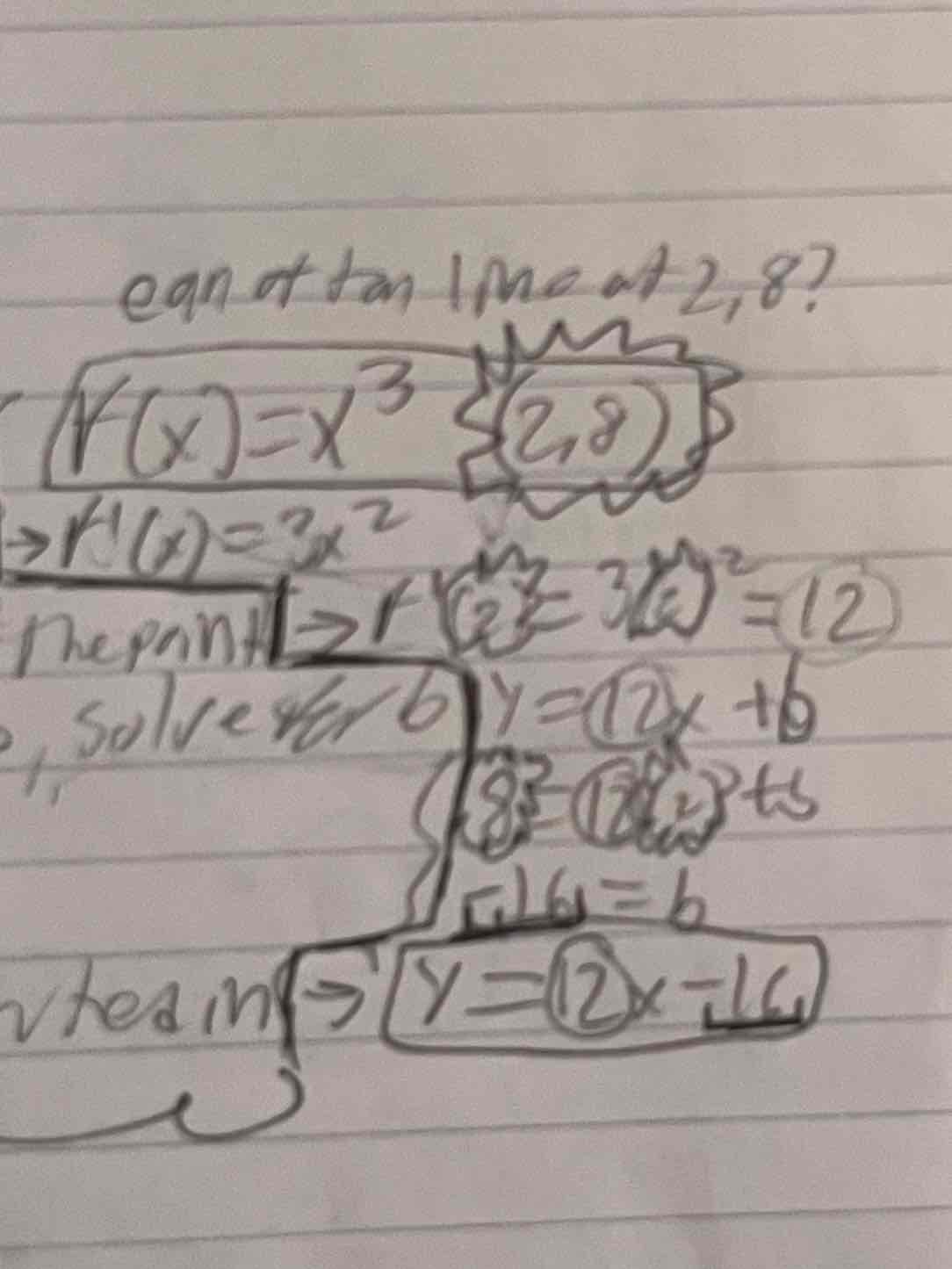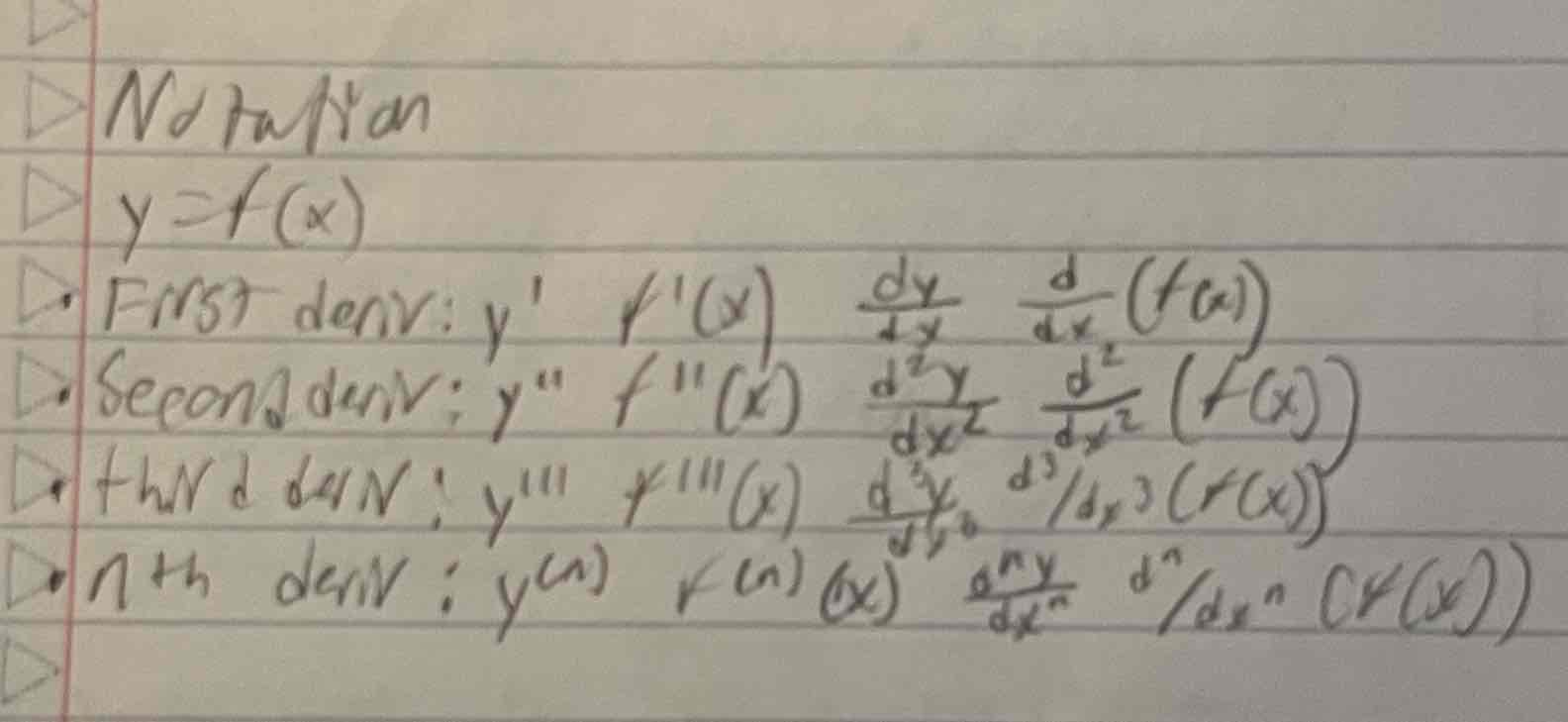calc unit 3 ig
1/24
Name | Mastery | Learn | Test | Matching | Spaced |
|---|
No study sessions yet.
25 Terms
d/dx(sin-1)
1/SQRT(1-x²)
d/dx(cos-1)
-1/SQRT(1-x²)
d/dx(tan-1)
1/1+x²
d/dx(sec-1)
1/|x|sqrt(x²-1)
d/dx(csc-1)
-1/|x|sqrt(x²-1)
d/dx(cot-1)
-1/1+x²
to find the equation of tangent lines, what are the 4 steps??
Find the derivative of the function
Find the value of the derivative at the point (plug in x at the specified point) (this is you SLOPE)
Plug in the point for x and y, plug in the SLOPE for m in y=mx+b and SOLVE FOR b
rewrite with m (slope) and b substituted it (leave y and x alone so it’s y=mx+b with only m and b)

what is the formula for the derivative of an inverse function (if g(x)=f-1(x))
g’(x)=1/f’(g(x))
Some tips for finding inverse derivatives
Take the inverse function point they want, find companion point on OG fcn, find the derivative of that OG point, take reciprocal
LOOK FOR COMPANION POINTS (5,7)→(7,5) their slopes are reciprocals
when should you use implicit differentiation?
when you can’t or don’t want to solve for y
when the dependent variable (y) isn’t isolated on one side of the equation already
Steps for implicit differentiation
Differentiate everything on both sides with respect to x (find the derivatives and the multiply it by d?/dx (dx/dx (which is 1), dy/dx))
collect terms with dy/dx one one side (and terms without it on the other)
factor out dy/dx
solve for dy/dx
what are high order derivatives?
derivatives of derivatives
how do you write high order derivatives?

s(t) is what?
position, original function
how do you measure s(t)?
units of length (feet, miles, meters, etc)
what is v(t)
velocity
derivative of s(t), v(t)=s’(t)
also tells you the direction of the object (direction tells you change in position)
how do you measure velocity?
units of length per units of time (meters per second, mph, etc)
what is a(t)?
acceleration
derivative of v(t), second derivative of s(t)
a(t) = v’(t) = s’’(t)
rate of change of velocity
in terms of speed acceleration is a force acting on an object
how do you measure acceleration
measured in units of velocity per unit of time (meters per second per second, meters/second²)
when is an object at rest?
when velocity (v(t)) = 0
when is an object moving left/down?
when velocity/v(t) is negative - (or <0)
when is an object moving right/up
when velocity/v(t) is positive + (>0)
how do you know an object is speeding up
if velocity and acceleration are going the same direction (have same sign (- - or + +))
acceleration is a force acting on a object: you’re going right (+velocity) and the wind (acceleration) is going right (+) you speed up
how do you know if an object is slowing down
if velocity and acceleration are going the opposite direction (have opposite sign (- + or + -))
acceleration is a force acting on a object: you’re going right (+velocity) and the wind (acceleration) is going left (-) you slow down
related rates steps
draw a picture, label everything, write down what you know (lengths, distances, rates of change of distances, labels, etc.)
find an equation that relays the variables (like a²+b²=c², or volume formula, etc)
differentiate implicitly, and plug in values you know to solve for the desired rate (YOU MIGHT NEED TO REWRITE VARIABLES IN TERMS OF OTHER VARIABLES IN ORDER TO DIFFERENTIATE AND SOLVE)
answer the question asked